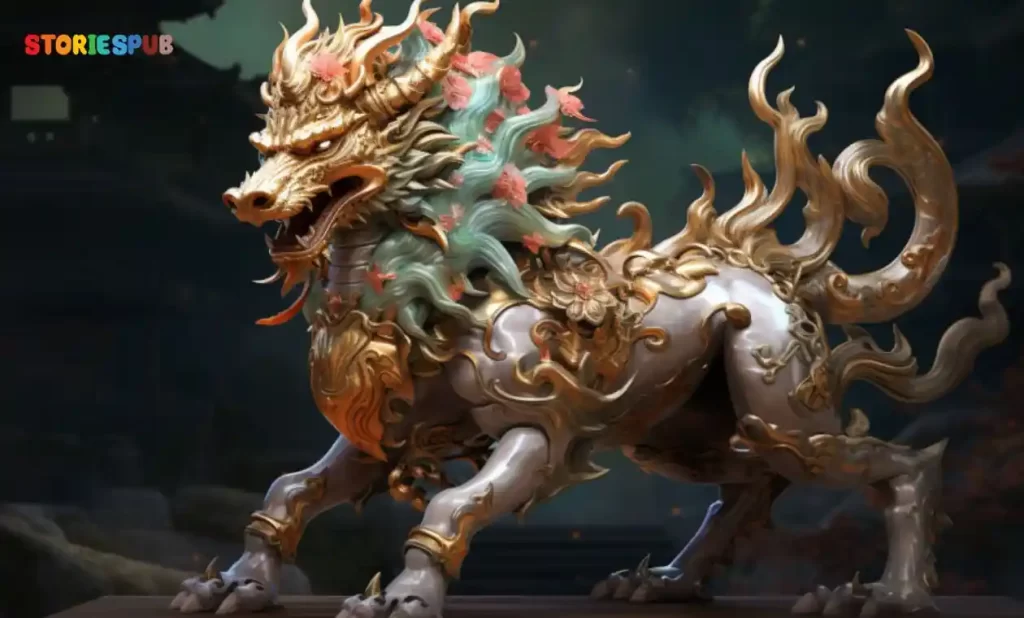Summarize this Article with:

Mythical creatures have long captivated the imaginations of people across cultures, serving as symbols of hope, fear, or the embodiment of human virtues and vices. In Chinese mythology, a rich tapestry of fantastic beings and magical stories has shaped the culture and beliefs of its people for millennia. Among these enchanting creatures, the Qilin stands out as a magnificent symbol of good fortune, benevolence, and righteousness.
Qilin’s Overview
The Qilin, also spelled as Kylin or Kirin, is a legendary creature that has been part of Chinese folklore since ancient times. Often described as a chimera-like being, the Qilin possesses the body of a deer or an ox, the head of a dragon or a lion, scales or fur covering its body, and a long, flowing tail. It is said to have the ability to walk on water and grass without disturbing either, signifying its gentle nature.
In Chinese mythology, the Qilin is considered one of the four noble and divine creatures, along with the dragon, the phoenix, and the tortoise. It is believed that the appearance of a Qilin heralds the arrival of a wise and benevolent ruler or the birth of a great sage. Throughout Chinese history, the Qilin has been associated with prosperity, peace, and the upholding of justice, making it a beloved symbol in Chinese art, literature, and cultural artifacts.
Famous Qilin Legends and Stories
The Birth of Confucius:
Confucius, one of the most influential philosophers in Chinese history, was born in 551 BCE in the ancient state of Lu (now part of modern-day Shandong Province). His teachings, which focused on morality, ethics, and social order, have had a profound impact on the development of Chinese culture and thought for over two millennia.
One of the most famous legends associated with the birth of Confucius involves the appearance of a Qilin, a mythical creature revered for its benevolence, wisdom, and auspicious nature. According to the legend, shortly before Confucius’s birth, a Qilin appeared near the home of his parents, Shu Liang He and Yan Zhengzai.
The Qilin carried a jade tablet in its mouth, which it gently laid down before the couple. The jade tablet bore an inscription, which prophesized that their son would grow up to be a wise and just ruler, a great sage whose teachings would bring peace and harmony to the world. This encounter with the Qilin was believed to be an auspicious sign, indicating that Confucius was destined for greatness from the moment of his birth.
In awe of the Qilin’s appearance and the divine message it carried, Confucius’s parents became convinced that their son was destined to have a profound impact on the world. They raised him with great care, ensuring that he received a comprehensive education in literature, history, music, and the arts.
As Confucius grew older, he began to develop his philosophical ideas, which emphasized the importance of virtue, righteousness, and proper conduct in both personal and public life. He traveled throughout China, sharing his teachings and attracting a devoted following of disciples.
The legend of the Qilin’s appearance at the birth of Confucius serves to emphasize the extraordinary nature of his life and his teachings. The story highlights the Qilin’s role as a symbol of wisdom, benevolence, and the ability to recognize and nurture greatness in others. It also serves as a powerful reminder of the potential for each individual to have a lasting impact on the world and to leave a legacy that endures for generations to come.
The Qilin and Emperor Wu of the Han Dynasty:
During the reign of Emperor Wu of the Han Dynasty (141-87 BCE), a Qilin was said to have been captured by imperial hunters in a remote region of the empire. Astonished by its magnificent appearance and aware of the Qilin’s symbolic significance, the hunters presented the creature to Emperor Wu as a rare and precious gift.
Emperor Wu, an ambitious and powerful ruler, was delighted with the Qilin, interpreting its capture as a sign of divine favor and approval of his rule. He believed that possessing the Qilin would bring good fortune and blessings to his reign. With great ceremony, he named the creature “Divine Brilliance” and ordered a special enclosure to be built for it within the imperial palace.
The Qilin, however, did not thrive in captivity. Accustomed to roaming freely in the wild, it grew increasingly despondent and weak. Despite the emperor’s efforts to provide for its every need, the Qilin’s health continued to deteriorate. Eventually, the once-majestic creature died, leaving the court in shock and dismay.
Emperor Wu, deeply troubled by the Qilin’s death, sought counsel from his advisors and court astrologers. They interpreted the death as a warning from the heavens, suggesting that the emperor’s actions and governance had not been as virtuous and benevolent as they should have been. The Qilin, a symbol of righteousness and justice, could not flourish under an emperor who did not embody these qualities.
Taking the death of the Qilin to heart, Emperor Wu embarked on a journey of self-reflection and introspection. He reconsidered his priorities, striving to become a more benevolent and just ruler. He implemented policies to improve the welfare of his subjects and promote the development of art, culture, and education throughout the empire.
The story of the Qilin and Emperor Wu of the Han Dynasty serves as a powerful allegory, reminding rulers and leaders of the importance of benevolence, wisdom, and justice. It highlights the fact that the true value of a Qilin lies not in its possession, but in the virtues it represents and inspires in those who encounter it.
The Qilin’s Gift to Emperor Yongle:
In the early 15th century, during the reign of the Yongle Emperor (1402-1424) of the Ming Dynasty, a remarkable event took place that would leave a lasting impact on the court and the people of China. The emperor received a rare and exotic gift from a ruler in Africa, the King of Malindi (in present-day Kenya): a giraffe.
The giraffe, a creature never before seen in China, captivated the emperor and his court with its unusual appearance. Its long neck, slender legs, and unique body markings led the imperial court to believe that the giraffe was, in fact, a Qilin. This belief was further reinforced by the giraffe’s gentle and graceful demeanor, which was reminiscent of the legendary Qilin’s benevolent nature.
The arrival of the “Qilin” was seen as an auspicious sign from the heavens, signifying divine favor and approval of Emperor Yongle’s rule. This was particularly significant given the controversial circumstances surrounding his rise to power. Emperor Yongle had seized the throne from his nephew, the Jianwen Emperor, after a bloody civil war. Consequently, his claim to the throne was viewed by some as illegitimate.
Eager to capitalize on the perceived divine endorsement, Emperor Yongle used the presence of the “Qilin” to justify his rule and solidify his position as the rightful emperor of China. He commissioned paintings, poems, and scholarly writings to celebrate and document the arrival of the “Qilin,” and to reinforce the connection between the creature’s appearance and his reign. The giraffe became a symbol of his power and the legitimacy of his rule, as well as a testament to the extensive trade and diplomatic connections he had established during his reign.
The story of the Qilin’s gift to Emperor Yongle serves as a fascinating example of how the symbolism of the Qilin has been used throughout history to confer legitimacy and divine favor upon rulers. It also highlights the power of myth and legend in shaping perceptions and the course of history. The giraffe, an exotic animal from a distant land, became a powerful political tool, embodying the virtues and qualities of the revered Qilin, and helping to secure the position of a controversial emperor.
The Qilin and the Scholar:
In ancient China, the imperial examinations were a prestigious and highly competitive means for talented scholars to earn government positions and social advancement. Success in these examinations was highly sought after, and young scholars devoted years of their lives to diligent study in hopes of achieving high scores.
One such scholar, a young man from a humble background, was known for his unwavering dedication and determination to succeed in the imperial examinations. He spent countless hours studying classical texts, history, and literature, driven by his desire to improve his family’s circumstances and serve his country.
One day, as the scholar was immersed in his studies, a Qilin appeared before him. The mythical creature, renowned for its association with wisdom and benevolence, presented the young man with a gift: a book containing the answers to all the questions that would appear in the upcoming imperial examinations. The Qilin explained that with this book, the scholar could easily achieve the highest score and secure a prominent position in the government.
The scholar, however, refused the Qilin’s generous offer. He believed that true success could only be achieved through hard work, perseverance, and dedication to his studies. Accepting the Qilin’s gift, he reasoned, would not only undermine his own efforts but also compromise his integrity and the fairness of the examination system.
The Qilin, deeply impressed by the young man’s display of virtue and commitment to his principles, decided to bless him with wisdom and success. Although the scholar did not accept the book of answers, the Qilin’s blessing endowed him with the ability to comprehend complex texts and ideas with ease, allowing him to excel in his studies.
In the end, the scholar achieved great success in the imperial examinations through his own merit, earning a distinguished position in the government and bringing honor to his family. His unwavering commitment to his principles and his refusal of the Qilin’s gift became a well-known story, inspiring generations of students and scholars to uphold the values of integrity, hard work, and perseverance in their own pursuits.
The legend of the Qilin and the Scholar serves as a powerful reminder of the importance of moral values and personal integrity in the pursuit of success. The story also highlights the Qilin’s role as a symbol of wisdom, benevolence, and the rewards that come to those who embody these virtues.
These stories showcase the Qilin’s role as a harbinger of good fortune and wisdom. The creature is often seen as a symbol of benevolence, justice, and righteousness, embodying the highest ideals of Chinese culture and serving as an inspiration for people to strive for greatness.
Qilin Characteristics
Physical Attributes and Common Depictions
The Qilin, a mythical creature in Chinese folklore, is often depicted as a majestic and gentle creature with a unique appearance that combines features of various animals. Although representations of the Qilin can vary across different regions and time periods, some common physical attributes include:
- Body: The Qilin is typically portrayed with the body of a deer, an ox, or a horse, covered in scales or a patterned coat that resembles the hide of a dragon.
- Head: The head of a Qilin is usually depicted as similar to that of a dragon, with a single horn or sometimes two antler-like horns on its forehead.
- Legs: Qilin legs are often portrayed as those of a horse or a deer, but with cloven hooves like an ox. In some depictions, the legs of a Qilin may be wreathed in flames or smoke.
- Tail: The tail of a Qilin is typically long and flowing, resembling that of a lion, an ox, or a horse.
- Mane: The Qilin often has a mane that runs from the top of its head down its back, similar to that of a horse or a lion.
Symbolic Meaning and Role
The Qilin is deeply imbued with symbolic meaning in Chinese culture, representing a wide range of virtues and qualities. Some of the most significant symbolic aspects of the Qilin include:
- Benevolence and Kindness: The Qilin is renowned for its gentle and benevolent nature, often depicted as a peaceful creature that does not harm any living beings. It is said to tread lightly on the ground to avoid stepping on grass and insects, and its presence is believed to bring peace and prosperity.
- Wisdom and Knowledge: As a creature associated with wisdom, the Qilin is often linked to scholars and learning. It is believed to have the ability to discern right from wrong and to recognize and nurture talent and virtue in others.
- Auspiciousness and Good Fortune: The appearance of a Qilin is considered a highly auspicious event, signaling divine favor and good fortune. In many legends, the Qilin is connected to the birth or reign of great rulers, philosophers, or scholars, symbolizing their exceptional qualities and the positive impact they will have on society.
- Justice and Righteousness: The Qilin is also seen as a symbol of justice and righteousness, embodying the highest moral standards and ideals. In Chinese mythology and literature, the Qilin often serves as a reminder of the importance of upholding these values in both personal and public life.
- Fertility and Protection: In some cultural contexts, the Qilin is considered a symbol of fertility and a protector of expectant mothers and their unborn children. Its appearance is believed to bring blessings for a healthy and prosperous offspring.
The Qilin, with its unique physical characteristics and symbolic significance, occupies a special place in Chinese mythology and culture. It embodies a wide range of virtues and ideals that continue to inspire and guide people in their pursuit of personal and societal betterment.
The Qilin and Its Connection to Good Luck and Fortune
In Chinese culture and mythology, the Qilin is regarded as a symbol of good luck and fortune, as its appearance is often associated with auspicious events, the arrival of virtuous individuals, or the beginning of prosperous times. The Qilin’s connection to good luck and fortune can be observed in several aspects of its mythology and cultural significance:
Divine Favor: The appearance of a Qilin is believed to signal divine favor and approval. In many legends, the Qilin appears before the birth or reign of great rulers or scholars, indicating that they have the support and blessing of the heavens. This divine favor is often interpreted as a sign of good fortune, as it signifies that the individual or the realm will prosper under their leadership.
Prosperity and Abundance: The Qilin is also associated with prosperity and abundance, as its presence is thought to bring with it a period of peace, wealth, and well-being. This connection is evident in various myths and historical accounts, in which the Qilin’s appearance is linked to the flourishing of a kingdom, the success of a ruler, or the achievement of a scholar.
Protection and Blessings: In some cultural contexts, the Qilin is considered a guardian and a bringer of blessings, particularly in matters of fertility and family. Its presence is believed to ensure the health, safety, and prosperity of expectant mothers and their unborn children, as well as to bless households with wealth and happiness.
Virtue and Wisdom: The Qilin is a creature deeply associated with virtue and wisdom, representing the highest moral standards and ideals. Its appearance is thought to inspire people to uphold these values, leading to a harmonious society where people treat each other with kindness, fairness, and respect. In this sense, the Qilin’s connection to good fortune is closely linked to the promotion of virtuous behavior and the creation of a just and prosperous society.
Auspicious Omen: The Qilin is often regarded as an auspicious omen, signaling the arrival of positive events or changes. Its appearance in dreams, art, or literature is commonly interpreted as a sign that good fortune is on the horizon, inspiring hope and optimism for a brighter future.
The Qilin’s connection to good luck and fortune is deeply ingrained in Chinese culture and mythology, reflecting its role as a symbol of divine favor, prosperity, and virtue. Its presence serves as a reminder of the potential for positive change and the power of virtuous actions to shape a more fortunate and prosperous world.
Qilin vs. Dragon vs. Phoenix: Unique Roles and Symbolism of Each Creature
In Chinese mythology and culture, the Qilin, Dragon, and Phoenix are all revered as powerful and auspicious mythical creatures. Each of these creatures possesses distinct roles and symbolism, representing various virtues, ideals, and concepts in Chinese thought.
Qilin:
Role: The Qilin is regarded as a symbol of benevolence, wisdom, and good fortune. Its appearance is considered a highly auspicious event, signaling divine favor, the arrival of virtuous individuals, or the onset of prosperous times.
Symbolism:
- Benevolence and Kindness: The Qilin is known for its gentle nature and is often associated with peace and prosperity.
- Wisdom and Knowledge: The Qilin is linked to scholars and learning, representing wisdom and discernment.
- Auspiciousness and Good Fortune: Its appearance is believed to bring good luck, divine favor, and prosperity.
- Justice and Righteousness: The Qilin embodies high moral standards and ideals, symbolizing justice and virtue.
Dragon:
Role: The Dragon is a symbol of imperial power, strength, and transformation. It is often associated with the emperor and is considered a divine creature that can control weather and natural phenomena.
Symbolism:
- Imperial Power and Authority: In Chinese culture, the emperor is often compared to a dragon, symbolizing his supreme power and divine right to rule.
- Strength and Power: The Dragon represents strength, power, and the ability to overcome obstacles.
- Transformation and Renewal: Dragons are associated with change and transformation, as they can shape-shift and bring rain to nourish the earth.
- Control over Natural Elements: The Dragon is believed to have control over water, rainfall, typhoons, and floods, reflecting its connection to nature and the elements.
Phoenix:
Role: The Phoenix is a symbol of grace, purity, and renewal. It is often associated with the empress and represents the feminine counterpart to the Dragon.
Symbolism:
- Grace and Beauty: The Phoenix is admired for its elegance, beauty, and grace, embodying the highest ideals of refinement and aesthetics.
- Purity and Virtue: The Phoenix is a symbol of purity, representing the qualities of virtue, chastity, and moral integrity.
- Renewal and Resurrection: The Phoenix is known for its ability to rise from its ashes, symbolizing renewal, rebirth, and the cyclical nature of life.
- Harmony and Balance: The Phoenix, when paired with the Dragon, represents harmony and balance, symbolizing the complementary forces of yin (feminine) and yang (masculine) in Chinese philosophy.
In summary, the Qilin, Dragon, and Phoenix each hold unique roles and symbolism within Chinese mythology and culture. The Qilin represents benevolence, wisdom, and good fortune; the Dragon embodies imperial power, strength, and control over natural elements; and the Phoenix symbolizes grace, purity, and renewal. Together, these mythical creatures reflect a rich tapestry of virtues, ideals, and concepts that have shaped Chinese thought and culture for millennia.
Qilin in Global Mythology: A Comparative Perspective
While the Qilin is a significant mythical creature in Chinese culture, it also has counterparts and connections to similar creatures in other cultures and mythologies around the world. These creatures, though not identical, share some common traits with the Qilin, such as their benevolent nature, auspiciousness, and association with good fortune. Some examples of these creatures in global mythology include:
Kirin (Japan): The Japanese Kirin is derived from the Chinese Qilin and shares many similarities with its Chinese counterpart. The Kirin is depicted as a gentle, auspicious creature with features of a deer, dragon, and other animals. It is believed to bring good fortune and is associated with peace, wisdom, and prosperity.
Unicorn (Western Mythology): The Unicorn, a mythical horse-like creature with a single spiraled horn on its forehead, shares some traits with the Qilin. Like the Qilin, the Unicorn is known for its benevolent nature and is often associated with purity, grace, and magical powers. Although the Unicorn is not explicitly linked to good fortune, it is considered a symbol of innocence, healing, and enchantment.
Karkadann (Persian Mythology): The Karkadann is a mythical creature that resembles a combination of a rhinoceros, a horse, and an elephant. Although its temperament is said to be more aggressive than the Qilin’s, it is believed to have a gentle side, especially towards smaller and weaker creatures. The Karkadann is associated with good luck and is believed to have magical properties, such as the ability to ward off evil spirits.
Sin-you (Chinese Mythology): The Sin-you is another mythical creature in Chinese folklore that has similarities to the Qilin. It is often depicted as a lion-like creature with a single horn on its head. The Sin-you is considered a guardian and protector, associated with good fortune and the ability to repel evil.
While the Qilin is a unique mythical creature with deep roots in Chinese culture, it shares some commonalities with various creatures from different mythologies around the world. These similarities highlight the universality of certain themes and values, such as benevolence, wisdom, and good fortune, which are embodied in the myths and legends of diverse cultures.
Qilin’s Presence in Movies, Books, and Games: A Glimpse into Popular Culture
The Qilin, with its rich mythology and symbolism, has made its way into various forms of popular culture, including movies, books, and games. Its appearance in these mediums serves to introduce the mythical creature to a wider audience and to showcase its significance within Chinese culture. Some examples of the Qilin’s presence in popular culture include:
Movies:
- “The Forbidden Kingdom” (2008): In this martial arts film, the Qilin is featured as a statue that comes to life, assisting the protagonists in their quest to return a magical staff to its rightful owner.
- “The Mermaid” (2016): In this Chinese fantasy film, a Qilin is briefly depicted as a creature residing in a magical realm.
Books:
- “Where the Mountain Meets the Moon” by Grace Lin: In this children’s fantasy novel, the protagonist encounters a Qilin who grants her a wish, playing a pivotal role in her journey to improve her family’s fortune.
- “The Qilin’s Grace” by Kelly Hibbert: This novel, set in a world inspired by Chinese mythology, features a Qilin as one of the central characters, exploring themes of friendship, loyalty, and destiny.
Games:
- “World of Warcraft”: In this popular MMORPG, the Qilin appears as a mount called the “Heavenly Golden Cloud Serpent,” showcasing its significance as an auspicious and revered creature.
- “Final Fantasy” series: The Qilin is featured as a summonable creature in several installments of this long-running RPG franchise, often associated with healing and support abilities.
- “Smite”: In this MOBA game, the Qilin appears as a mount for one of the playable characters, highlighting its role as a guardian and protector in Chinese mythology.
The presence of the Qilin in movies, books, and games demonstrates its enduring appeal and cultural significance, both within China and beyond. By featuring the Qilin in various forms of popular culture, creators can introduce audiences to the rich tapestry of Chinese mythology and foster a deeper appreciation for its unique creatures and stories.
Conclusion
In conclusion, the Qilin is a fascinating and significant mythical creature in Chinese culture, embodying virtues such as benevolence, wisdom, and good fortune. With its complex symbolism and association with auspicious events, the Qilin has captured the imagination of people for centuries, inspiring countless legends, stories, and artistic representations.
The Qilin’s influence can be observed in various forms of popular culture, including movies, books, and games, where it serves as a bridge between ancient mythology and modern audiences. Additionally, the Qilin shares similarities with mythical creatures from other cultures, highlighting the universality of certain themes and values that transcend geographical and cultural boundaries.
By exploring the various aspects of the Qilin, from its origins in Chinese mythology to its presence in global popular culture, we gain a deeper understanding of the rich tapestry of Chinese culture and the enduring appeal of its mythical creatures. The Qilin’s enduring legacy serves as a testament to the power of myth and the human imagination to create, inspire, and captivate the hearts and minds of people across generations and cultures.
Hey kids, how much did you like Qilin: The Magnificent Chinese Mythical Creature? Please share your view in the comment box. Also, please share this story with your friends on social media so they can also enjoy it, and for more such Chinese Mythology, please bookmark storiespub.com.
Related Post :









